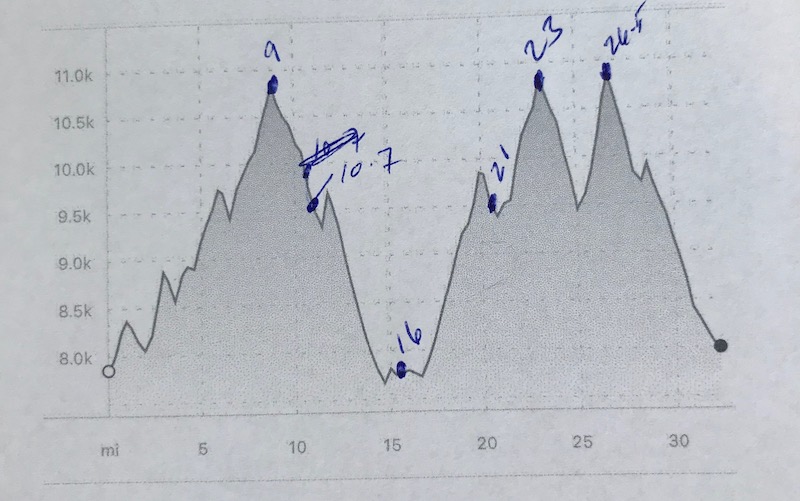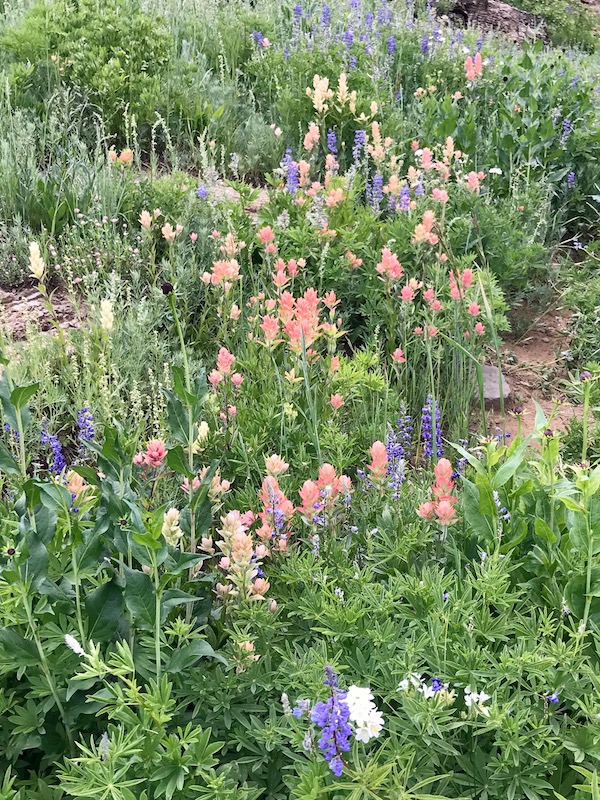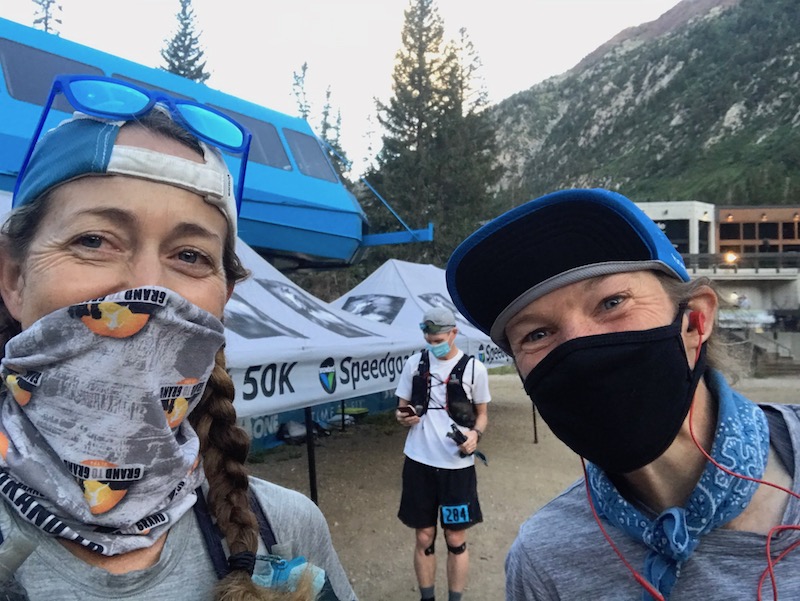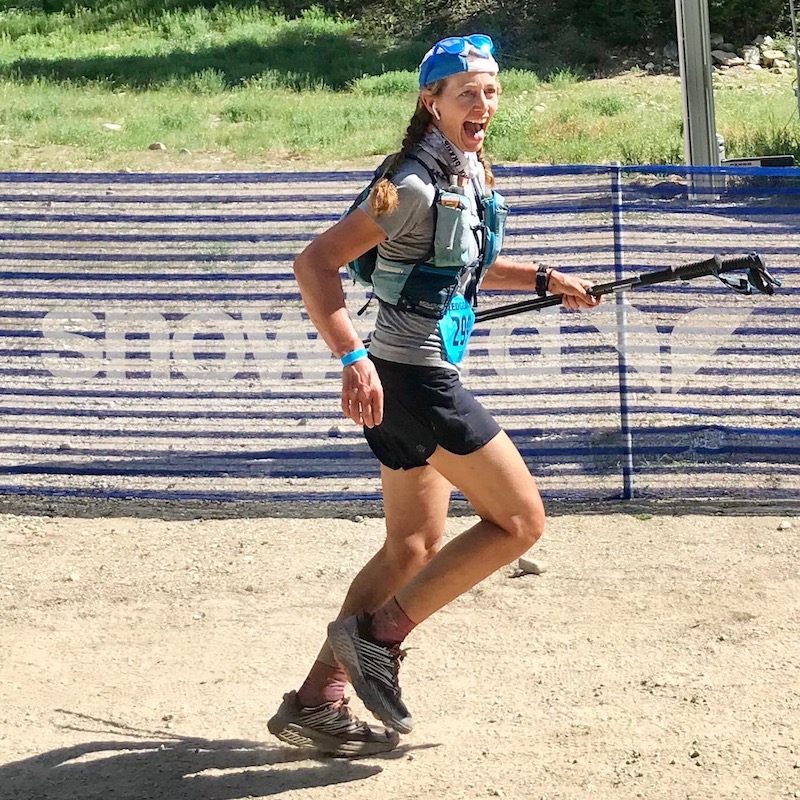The Speedgoat 50K started so auspiciously. I woke up at 4:30 a.m. Saturday, July 25, in a hotel room in Salt Lake City—appreciating the novelty of a get-away weekend during this pandemic, being uber-careful not to spead or acquire germs along the way—and engaged in my pre-race routine. Going through the motions of pinning on a bib, braiding my hair, lubing my toes, and taping the spots on my chest and back that are prone to chafing evoked a familiarity of doing something so habitual that we call it second nature.
The last time I got ready for an ultra, and the last time I was in Salt Lake City, was early February for the Running Up for Air event. It’s been five months but feels like two years. I have not felt much like an ultrarunner lately. Following a big 179-mile week in late May when I fulfilled a Double Everest challenge, I drastically reduced running in June. I did not train specifically for this 50K and had logged only two 20-mile long runs in the past five weeks. I was counting on muscle memory and determination.
At the packet pickup the day before, I met three others from Telluride—Dave Chew, Kelly Wolf and Sam Tischendorf. Everyone seemed a little giddy with escape. Kelly, an elite-level runner recently relocated to Durango, was racing for the first time after a hiatus from injury. Dave, a bit of a dark horse relatively new to the ultra scene, had a lot of potential. Sam, doing the event’s shorter course as a training run for a big September ultra, had never traveled to race out of state before. I felt like the older mom of the group that I am.

Sam, Dave, Kelly and me the afternoon before the race.
Saturday morning, I drove to the Snowbird ski resort for my 6:40 start time. The nearly 200 runners registered in the 50K and 100 or so in the 28K had strict instructions about how and when to start, under new protocols to keep runners relatively distanced and uncrowded.
I’d been here before, three years ago for the 2017 edition of the race, but my memories of the route were hazy and mixed with memories from the 2015 Wasatch 100, which also crisscrosses these mountains. I only remembered that it’s a ridiculously tough 50K+ (about 33 miles) with some 11,000 feet of elevation gain, with the low points of the course around 7500′ elevation and the high points close to 11,000. That’s not too tough by Telluride standards (where the trails top out on 13ers), but Speedgoat, as I recalled, tripped me up literally and mentally with its treacherous, rock-strewn, steep-as-a-ladder downhills.

The Speedgoat 50K (33ish mile) elevation profile, with my messy markings of aid station locations.
My time in 2017 was 8:57, which is very slow for a 50K (about 16:15/mile average) due to all the miles hiking steep uphills at only about 20 minutes/mile. This year, I wanted to do as well as I did three years ago and break 9 hours.
Shortly after parking, I spotted Nick and Jade de la Rosa, a couple from Sedona I got to know last fall when sharing their story for a feature article for iRunFar. They have been through so many challenges, I got a lump in my throat seeing them.

Nick and Jade at the start of Speedgoat.
I pondered how everyone at the starting line and nationwide has been through unprecedented challenges this year, which may go from bad to worse this fall and winter.
It’s not unreasonable to think we could witness a breakdown of democracy and a violent transfer of power in November. It’s not unreasonable to think that my relatives and friends could be hospitalized for the coronavirus, and that my college-age son and so many others looking for work and seeking a good education will lose any flicker of optimism in the coming year because the economy and our schools are irrevocably damaged by the national failure to respond effectively to the pandemic. It’s unfathomable to think that about 50 times the number of people who died in 9/11 have died here in the United States from COVID-19 since the outbreak early this year (150,000+ vs. almost 3000). Only four months ago, at the end of March when my husband was hospitalized with COVID-19 pneumonia, lots of headlines noted that coronavirus deaths had just exceeded the 9/11 toll, and now we’re at 50 times that loss.
These thoughts don’t disappear just because I’m in a beautiful location with the privilege of health and money to travel here for a day of recreation. Instead, they heighten my desire for an escapist day, when I suspend those worries on a mental shelf and turn off the news and listen to music instead. They enhance my appreciation for the normalcy and friendliness of people gathering to run or to volunteer at aid stations, and for the simple yet exquisite and fleeting beauty of running through knee-high melon-colored paintbrush flowers.

Wildflowers like this bloomed in abundance over parts of the Speedgoat 50K, where the route traversed ski slopes and meadows.
With those dark thoughts hovering, I resolved to have a good day even if I performed poorly, because as my first coach, Alphonzo Jackson, used to tell me in the late ’90s, “Any day you can run is a good day.”
Gathering with my pod of starters, I didn’t see any other women. A little less than 25 percent of the field was female. I was one of only four older ladies in the 50 – 59 category. I therefore was happy to spot and hang out next to the other Sarah, Sarah McCloskey, whom I met in 2017 and interviewed for this article on “three strategies to finish fast in your next trail race.”

The other Sarah and me, photobombed by guy on phone. We all wore masks at the start and when at aid stations, but we were allowed to run without them.
I took off in the fresh, cool mountain air, alternately hiking and running up the first set of switchbacks, then paused near the one-mile mark to take in an astounding site: two horse-sized moose munching on grass. I’d only seen moose twice before in my life, in Wyoming and Alaska. These were darker and bigger, with magnificent antlers. What a gift to see!

Moose in the first mile!
I felt great up to the first aid station at mile 9, at the top of a ski slope. I do 3500-foot ascents in high altitude like this regularly in Telluride, so it did not feel too challenging. The chunky-rock talus field did not trip me up. But, I wasn’t even at 10 miles.

A stretch of trail on the first climb, ski lifts always in view.

The trail cut through lots of chunky, wobbly talus.
My first “uh-oh” came on the descent after the first peak. The route plunged down steep singletrack covered with pebbly loose rock, like kitty litter covering a playground slide. Even though I had trekking poles for stability, my feet slid out from under me. I regained footing, then slipped again and landed hard on my butt. I moved to the side so other runners could bomb down, and I realized there’s no way I could run fast like them because I lacked the agility and stability. I had to inch my way down on the grassy side of the trail where I could gain better traction, because the trail itself was so steep and unstable. Then it hit me: My shoes, which had a lot more than 500 miles of wear on them, had worn-out treads. The underside of the soles were nearly as smooth as my son’s skateboarding sneakers. I’ve been cheap and lazy about replacing my Hoka Speedgoats (shoes that share the nickname of this race and its founder, Karl “Speedgoat” Meltzer). Now I’d pay for it! Damn.
I thought I could make good time on the extended downhill to the midway aid station. I thought wrong. This stretch from about mile 13 to 15 is like a long dry riverbed, utterly uneven and rock-strewn. I hopscotched over the rocks as best I could, but I was stumbling more than floating or flowing. Finally the downhill leveled out to some runnable road miles, and I steadily ran these sections without walk breaks even though the temps felt toasty, in the high 80s with high-altitude direct sun beating down.
I took time at the mile 16 aid station to eat some delicious watermelon and chug a ginger ale. The aid station volunteers were champs. Everyone was careful to keep distance and let the masked and gloved volunteers serve snacks to individuals using tongs. Grubby hands pawing through platters of food at aid stations are a thing of the past. When I left the aid station, I was pleased to see I was on pace for a 9-hour finish.
The thing about Speedgoat is, the second half is harder than the first half, because the route ascends not one but two very spiky tough summits, then detours to a diabolical stretch of singletrack with a relatively short but crushing climb before finishing on several miles of double-wide track. I put in AirPods, turned on my playlist and powered up the mountain to the mile 21 aid station repeating one of my favorite mantras, “so far, so good.”
The ascent around mile 22 makes the prior miles seem almost as mild as a jog around a golf course. The route goes cross country up a ski slope that is as challenging as the top half of Telluride’s Rundola, which goes up a black-diamond run. It’s so steep that you have to lean into the hill and use your hands to keep from tipping backwards, and if you stand up straight and look down, you’ll experience vertigo and risk rolling all the way back down. I took a photo of the ant-sized runners ahead of me, but trust me, this part of the route is longer, steeper and harder than the photo makes it appear.

Around mile 22, ascending to the Tunnel Peak aid station.
I crept up the hill, got to the top, and that’s where the trouble began. Along the rocky ridge line to the descent, I felt as if I’d lost any ability to move my legs and feet down the mountain. A dull pain radiated from my arthritic lower back, and I became fearful of slipping and jarring my backside. Running became tiptoeing, which led to mentally berating myself for being so slow and timid.
During the final 10 or so miles, the realization hit that I was in shape for a tough 20-miler, not a tough 33-miler. Frustration boiled over as my feet slipped and I fell hard on my tailbone yet again. I lost hope of finishing anywhere near 9 hours; it might take me 10 hours. At the final aid station at the top of the Hidden Peak ski lift, around mile 26.5, I did something I rarely do in ultras: I sat in a chair (“beware the chair”) and took time to hit “reset” as I drank more ginger ale.
I willed myself to practice self-compassion and remind myself that I was doing something only a very few number of people can do under normal circumstances, and a much smaller fraction can do during this pandemic. This race may feel like it sucks, and I may think that I suck, but I’m actually fortunate to suffer these final miles of this route. That’s what I told myself, anyway, and it helped. I muddled through the final six miles. It wasn’t pretty—I had to tiptoe and inch my way down another singletrack slope where I failed to gain footing and slipped repeatedly—but I got it done.
I finished in 9 hours, 43 minutes. Sam was nice enough to stick around after finishing the 28K event and to take this picture of me. I’m open-mouthed because I’m making a face at her and yelling, “I’m so slow!”

Finishing the Speedgoat 50K
Predictably, happiness replaced frustration. I felt proud I finished solidly mid-pack in spite of being under-trained and in spite of losing steam in the second half. (Results.)
The experience made me rethink my ultra plans for the remainder of the year. I had signed up for the Mogollon Monster 100 in Arizona in mid-September, if it happens (an “if”). I registered for it after my goal 100-miler for the summer got cancelled, and I wanted a Hardrock qualifier. Mostly, I wanted to finish a mountainous 100M before the year’s end, since I haven’t successfully completed a tough 100M since 2017.
But Speedgoat gave me a reality check. I can’t get ready for that 100M in a mere six weeks. I want to do my next 100 well prepared, not leverage experience and “muscle memory.” Therefore, in the days following Speedgoat, I pulled out of that 100 and set my sights on some shorter ultras this fall.
Next up is the virtual Boston Marathon, which I can complete sometime during the week of Sept. 7. I will spend this month refocusing my training on steady running with speed work, fewer gnarly mountain treks that involve substantial hiking, so that I can actually run the full marathon in a respectable-for-high-altitude time. This past race made me motivated to train and to be a competitive runner again, which is a good feeling under these circumstances.
Personal note
I have a few spots open to take on additional coaching clients; see my coaching page for info and contact me if you’re interested. Or, buy my book to effectively self-train!
Bonus en español
In March, to help cope with anxiety and loss of normalcy brought about by the pandemic, I restarted studying Spanish. I’ve been a Spanish learner off and on throughout adulthood, mostly self-taught (having studied French in high school and college). This spring, I hired a tutor who lives in Mexico, and we meet weekly by Zoom. My homework this past week was to write an essay to practice various past tenses for verbs, so I wrote a mini race report in Spanish. Here it is!
“Ojalá me hubiera entrenado más, pero no me preparé bien para la carrera”
El fin de semana pasado, viajé a Utah, cerca de La Ciudad del Lago de la Sal (Salt Lake City), para correr en una carrera de 52 kilómetros. Esta carrera es uno de las ultra maratones más difíciles a causa de la altitud y el aumento de la elevación. La ruta sigue senderos a través de montañas y sube muchas pistas de esquí. La carrera comienza a la altitud de 7500 pies (2300 metros) y sube tres cimas cada a 11,000 pies (3350 metros), y el aumento de altura total es más de 11,000 pies.
La carrera se llama “Speedgoat” (en español, Cabra de Velocidad) porque eso es el sobrenombre del director, el corredor Karl Meltzer, que ha ganado la mayor cantidad de carreras de 100 millas; él combina velocidad y agilidad como un cabra de montaña rápido.
Yo había corrido esta carrera en 2017, y ese año, llegué a la meta en 8 horas, 57 minutos. (Normalmente, una carrera de 50K me cuesta de 5 a 6 horas, pero esta ultramaratón es tan desafiante que algunos corredores requieren hasta 12 horas para terminar.)
Este año, yo esperaba poder alcanzar la meta en menos de 9 horas otra vez. Pero, podría correr como “una cabra de velocidad”?
Todos los corredores y yo nos sentíamos agradecidos por reunirnos y correr juntos, porque el Speedgoat fue la primera ultramaratón en tomar lugar desde la pandemia. Comenzamos la carrera en grupos pequeños de 20, cada 10 minutos, para tener espacio entre nosotros.
Durante la primera mitad de la carrera, me sentía fuerte y contena. Las flores silvestres se veían hermosas! Pero cuando bajé la primera gran montaña, comencé a resbalarme y caerme. Me di cuenta que mis zapatos eran demasiado viejos. Debía haber comprado unos nuevos. Si hubiera comprado nuevos zapatos, habría corrido con más confianza por la montaña rocosa y resbaladiza. Pero las suelas de mis zapatos estaban gastadas y me resbalé y me caí muchas veces sobre las piedras sueltas.
Después del mediodía, hacía mucho calor y yo estaba muy cansada. Tenía mucha sed. En vez de correr, solamente pude caminar lentamente cuando estaba subiendo el sendero. Ojalá me hubiera entrenado más, habría ido más rápidamente, pero no me preparé bien para esta carrera.
A veces, pensaba en dejarla para volver al hotel y descansar. Esperaba que la carrera hubiera sido solamente 20 millas en vez de 33. A mi no me gustó el dolor de las últimas millas! Además, me di cuenta que no podía llegar al final en menos de 9 horas.
Pero sabía que me habría sentido triste si no hubiera terminado. Entonces, me promité terminar lo que comencé. Las últimas millas eran tan duras pero paso a paso, alcancé la meta. Mi tiempo fue 9 horas, 43 minutos. Estaba avergonzada de ser tan lenta, pero, estaba orgullosa de terminar.
Solo hubo otras tres mujeres corriendo que tenían más de 50 años como yo, y cada una de ellas pasó mas de 12 horas para completarse! Hubo 35 mujeres en total (comparado con 117 hombres) y fui la mujer 14 para terminar.
¡Ahora, me siento motivada para entrenarme para la próxima carrera!

[…] —Sarah reports from her run at Speedgoat last weekend. […]